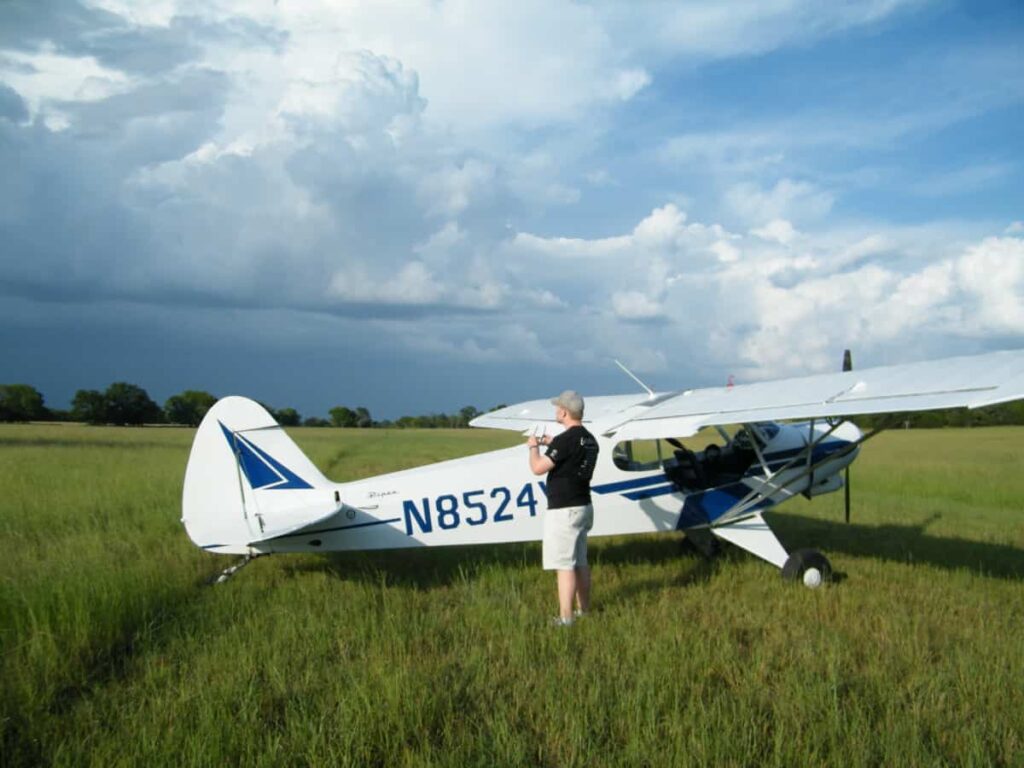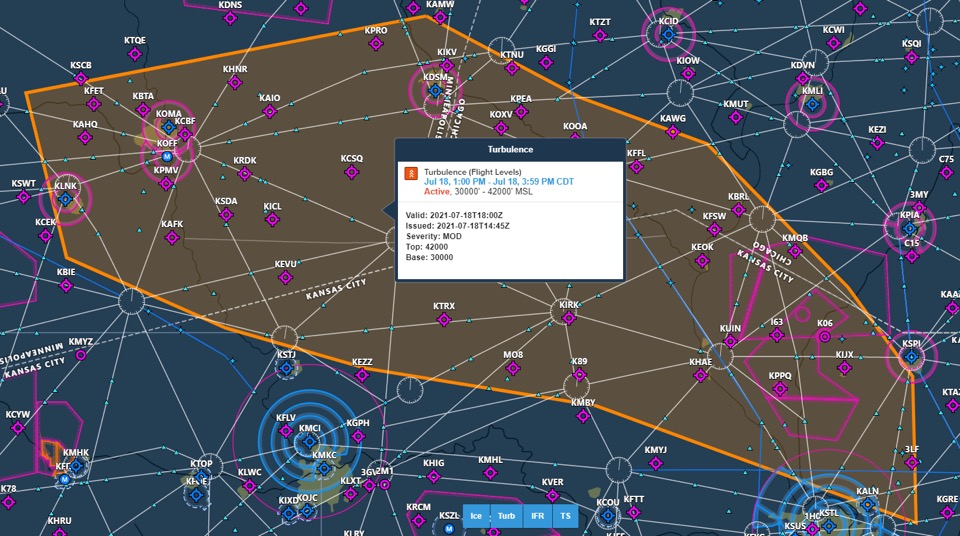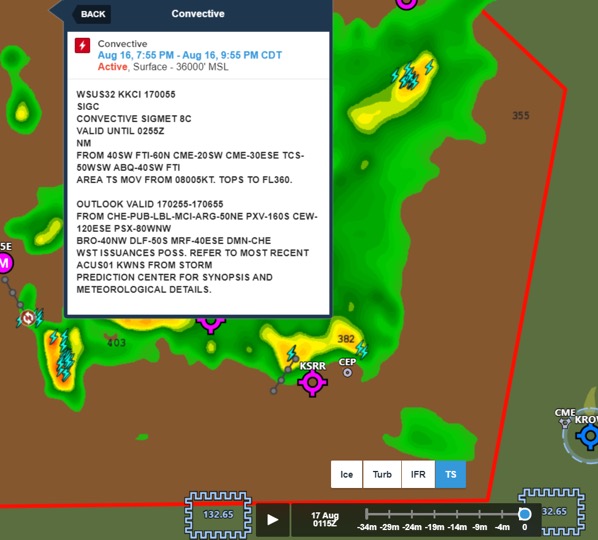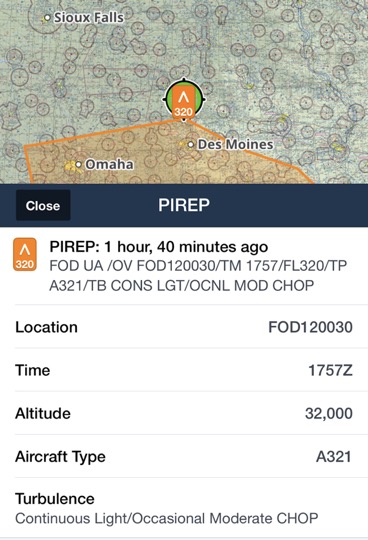
Every time I want to take a passenger flying with me, especially a first-timer, I plan the flight to maximize the odds that the ride is smooth, or turbulence-free. If I am traveling solo or into challenging weather conditions, I strive to avoid regions of turbulence that could make my flight unsafe.
Sometimes my passengers will ask if it will be a bumpy ride, and if pilots can avoid turbulence.
Pilots determine the area and altitude of light to extreme turbulence with weather forecasting tools such as AIRMETs and SIGMETs, as well as actual pilot reports, or PIREPs. Pilots can request routing or altitude changes to avoid these areas of turbulence if it is too uncomfortable or unsafe.
Since turbulence cannot always be seen, it is challenging to avoid it on every flight. This post will explore the causes and hazards of turbulence, discuss the tools and techniques to avoid it, and equip you with a plan to recover from unexpected turbulence.
Can pilots avoid turbulence?
Turbulent air, in many cases, is invisible to pilots. As a result, we have to rely on weather predictions and reports to avoid turbulence that could be uncomfortable or unsafe.
There are a few tools available to pilots to help predict and report turbulence, and pilots have the responsibility of using these tools prior to departure to collect information regarding predicted turbulence along the planned route of flight.
During the flight, pilots can provide reports to Air Traffic Control (ATC) that indicate whether those predictions were correct. These pilot reports can assist other pilots whose route of flight takes them through the same airspace.
Three useful tools available to help pilots determine the presence of turbulence are AIRMETs, SIGMETs, and PIREPs.
AIRMETS for Turbulence
A typical weather briefing includes a review of current AIRMETs, or Airmen’s Meteorological Information.
An AIRMET advises of weather potentially hazardous to all aircraft currently affecting or forecast to affect a widespread area.
There are subtypes of AIRMETs that cover specific types of weather. An AIRMET Tango is issued for forecast turbulence (Tango = Turbulence).
AIRMET Tango’s are generated when moderate turbulence (moderate explaining the intensity, described later in this article) or sustained surface winds of at least 30 knots are forecasted.
An AIRMET Tango contains the following information:
- High or low altitude classification
- Valid forecast times
- Issue time
- Severity
- Base altitude
- Top altitude
AIRMETs can be accessed in many ways, including my favorite app, ForeFlight.
The ForeFlight image below shows an example of a High altitude AIRMET Tango for moderate turbulence forecast between 30,000 feet (FL300) and 42,000 feet (FL420).
A forecast such as this might lead to the re-route of an airliner to avoid the area of predicted turbulence. Or due to the turbulence only forecasted to reach moderate severity, the flight might continue onward as planned (discussed later in the article).
However, a piston aircraft flying along an identical route at 8,000 feet MSL should not expect any turbulence.

SIGMETs
SIGMETs (Significant Meteorological Information) are more severe than AIRMETs. A convective SIGMET is generally associated with lines or areas of thunderstorms and implies severe or greater turbulence.
Moderate or Severe turbulence often occurs around thunderstorms due to the significant instability of the air (see What Makes Air Turbulent section below).
Areas with convective SIGMETs should be flown through cautiously (if at all) as they are prone to produce meteorological conditions involving intense turbulence and other hazardous weather.
The figure below shows a convective SIGMET and an associated line of thunderstorms approaching Sierra Blanca Regional Airport in New Mexico (KSRR).

In order to minimize the risk of turbulence, a pilot would want to plan their route to stay at least 20 nautical miles away from the region of storms.
If the pilot was flying into KSRR, the safest option would be to wait for the storm to pass before landing. This is because turbulence is usually greatest on the front-side of the storm.
ATC’s Role in Helping Pilots Avoid Turbulence
Air traffic controllers play an important role in helping aircraft safely navigate while avoiding turbulent storms.
The image below shows arrival traffic into Atlanta-Hartsfield International Airport being routed between two storm cells.
As the aircraft fly through the area, pilots can report the weather conditions present, which helps the controllers decide whether to keep routing the aircraft between the storm cells or pick a route with better weather conditions.

At the end of the day, it remains the pilot’s responsibility to manage and maintain the safety of each flight.
However, Air Traffic Control typically plays a very helpful role in warning the pilot of areas of heavy precipitation (or even helping guide them around it), and informing them of other pilot reports (PIREPs) in the area.
PIREPs
Pilot Reports (PIREPs) provide a time-stamped data point of conditions as observed by other pilots in the air.
PIREPs substantiate forecasts by confirming the presence of turbulence or other significant weather at a specific location, and they are also used to indicate when the actual weather does not align with the forecast (more or less turbulent than predicted).
The figure below shows a PIREP just outside the boundary of the forecast area of high-altitude turbulence that we examined earlier.
A report such as this one informs the pilot that turbulence exists at 32,000 feet just outside of the forecast area but at the same intensity (moderate) as what was forecast in the AIRMET.

To summarize, AIRMETs and SIGMETs provide forecasted weather conditions that give pilots the information to create routes and select altitudes where turbulence is least likely to exist.
PIREPs tell us actual reports (not forecasts) that show where the forecast was correct and where it was not.
Levels of Turbulence Intensity
Pilots use the knowledge gained from forecasts and pilot reports to route themselves around turbulence (or request route amendments from ATC).
In situations where pilots cannot avoid turbulence, they have to decide if the turbulence is safe enough to fly through. To do this, they consider the four levels of turbulence, outlined below.

Although light turbulence gathers the attention of the passengers, pilots can safely navigate through light turbulence.
Moderate turbulence can be uncomfortable for passengers, and if possible, pilots may request an altitude or reasonable routing change to find smoother air.
Strong Moderate turbulence (heading towards Severe) may require that the aircraft be slowed down to reduce the impact of turbulence and keep the aircraft within its structural limitations.
Severe and Extreme turbulence should be avoided.
The Difference in Turbulence and Chop
Turbulence gets the most attention, but there’s another kind of air disturbance called “chop” that gets reported as well.
The main difference is that chop will not cause appreciable differences in the aircraft’s altitude or attitude (roll, pitch, or yaw), while turbulence will. Chop can also only be reported as light or moderate, whereas turbulence can be light, moderate, severe, or extreme.
For more reading on this, see our article on the important difference in turbulence and chop.
Can an airplane withstand turbulence?
Airplanes are designed to be able to resist a certain level of airframe stress during flight (called “load factor”). This creates margin for turns, climbs, descents, wind shear, and turbulence.
In an effort to provide smoother rides, some commercial airliners and business jets are being designed with turbulence in mind.
For example, the Bombardier Global series of business jets are currently being assembled with passive design features that provide a smoother ride.

Bombardier Global Express – Image Credit
Some larger airliners are equipped with both passive and active systems to combat turbulence, such as high wing loading, increased wing flexibility, and gust mitigation systems.
High Wing Loading
The wing loading, or the mass of the airplane divided by the wing’s surface area, has a direct impact on how the aircraft responds to turbulence.
Consider two aircraft of the same weight but with wings of different sizes. The aircraft with the smaller wing is less impacted by turbulence, because there is less wing area to be disturbed by rough air.
The wing of the Bombardier Global series has been designed with a high wing loading to minimize the impact of any encountered turbulence.
Increased Wing Flexibility
The wing acts as a springboard to absorb the small bumps in the atmosphere that cause turbulence. The Bombardier Global series wing has been designed with increased flexibility.
If the plane does encounter turbulence, the flexible wing is able to absorb some of the loads by bending, rather than transmitting them straight into the fuselage.
While at first glance this might appear troubling to passengers seeing the wing flex during turbulence, it is intentional and by design.
Gust Mitigation Systems
I did some research and learned that gust mitigation systems were first installed on the airliners in the 1980s. They measured the aircraft’s movement in turbulence and responded by commanding control surfaces to dampen the response.
Although somewhat effective, these systems were limited, because the control laws were reactive in nature, only commanding after the turbulence had already been felt.
Today, some of the newest airliners have proactive gust suppression systems installed. These systems use radar and precise tracking of the aircraft’s movement to detect upcoming turbulence milliseconds before it occurs.
When imminent turbulence is detected, a computer command is sent and the control systems move just as the aircraft encounters the turbulence. This proactive approach performs significantly better than initial reactive systems and makes for a smoother ride.
The Boeing 787 is an example of an aircraft that employs all 3 design features: A flexible wing, a high wing loading, and a proactive turbulence suppression system.

Boeing 787 Dreamliner – Image Credit
What about small GA airplanes, will we see gust mitigation systems in the marketplace soon?
Due to the complexity of the required systems and sensors, and small number of control surfaces on smaller GA airplanes, I would not expect to see such systems emerge for many years.
What makes the air turbulent?
We’ve covered much of how airplanes avoid turbulence, but how does air become turbulent in the first place?
Turbulence is unstable air that is generated by either thermodynamic or mechanical means.
There are four main causes of turbulent air:
- Temperature Instability
- Obstructions (mountains/buildings)
- Wake Turbulence
- Jet Stream
For Causes #1 and #2, our article on Why Clouds are Often Turbulent explores how the thermodynamics associated with uneven heating and clouds create turbulence. The article also examines obstruction turbulence.
Wake turbulence (Cause #3) is a byproduct of the lift that a wing generates in the form of wingtip vortices. See our article How Does an Airplane Form Wake Turbulence for a more detailed explanation.
The Jet Stream (Cause #4) is a current of air characterized by strong winds flowing from west to east.
The Polar Jet Stream most commonly impacts the United States and is formed by the boundary between cold air near the poles and the temperate air associated with the middle-latitudes.
As weather patterns change the temperatures in these regions, the jet stream shifts. Winds in the jet stream can reach speeds greater than 100 knots in the center, with a sharp drop-off in wind speeds as you exit the jet stream.
Due to the steep wind speed gradient and the variation in location of the jet stream, many jets flying through it experience light to moderate turbulence.
All four types of turbulence can range in strength from light to extreme and in frequency from occasional to constant depending on the weather conditions present. See the chart above for more detail on turbulence severity. In some cases, turbulence can be dangerous, or even deadly.
Can turbulence cause airplanes to crash?
Light and Moderate turbulence pose more of a comfort threat than a safety threat to aircraft. Severe and Extreme turbulence could lead to loss of control of the aircraft which may lead to irrecoverable aircraft behavior or damage.
When encountered in Instrument Meteorological Conditions (IMC), such as flying through storm clouds, turbulence can lead to disorientation and eventual loss of control.
Other forms of turbulence can be dangerous, too. Wake turbulence has led to serious incidents and some accidents.
In 2020, a Bombardier Challenger business jet encountered severe wake turbulence from a heavy Airbus A380 passing overhead. The aircraft rolled upside-down multiple times and lost over 9,000 ft of altitude before the pilots were able to recover.
For more reading on this topic, see our article on how airplanes form wake turbulence and the dangers associated with it.
Conclusion
Turbulence should be taken seriously as it not only impacts the comfort of each flight but also its safety.
Thankfully, there are a growing amount of tools and resources to forecast turbulence before it arises, and aircraft and ATC alike are getting equipped with more advanced technology to reduce the number of hazardous encounters with inclement weather.
Becoming familiar with the tools available to remain in safe flying conditions should be a priority for every pilot!



